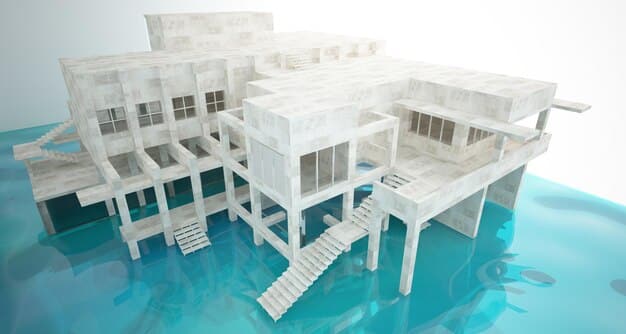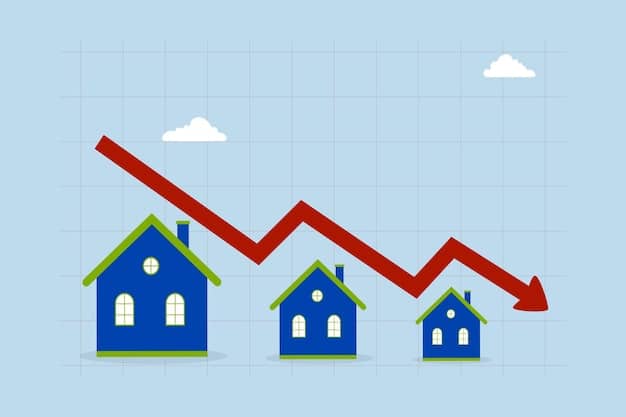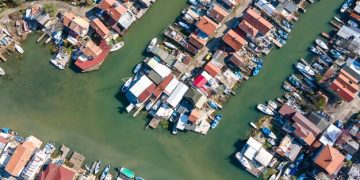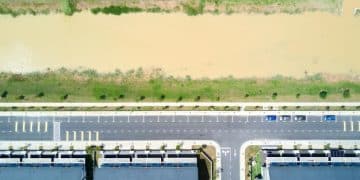Coastal Housing 2030: Adapting to Rising Sea Levels

Navigating the complexities of coastal living in the face of escalating sea levels demands innovative solutions, with proactive adaptation measures and resilient infrastructure development becoming critical for ensuring the long-term viability of communities by 2030.
The imperative of addressing The Future of Coastal Housing: Adapting to Rising Sea Levels by 2030 is no longer a distant concern, but an immediate challenge confronting communities globally. As climate change accelerates, coastal regions face unprecedented threats, from increased flooding to land erosion, necessitating a radical rethinking of how we build, protect, and inhabit our waterfront properties.
The Unfolding Reality of Rising Sea Levels
The scientific consensus regarding rising sea levels is unequivocal. Data from organizations like NOAA and the Intergovernmental Panel on Climate Change (IPCC) consistently point to an accelerating trend, driven primarily by thermal expansion of warming ocean waters and the melting of glaciers and ice sheets. Understanding the nuances of this phenomenon is the first step toward effective adaptation.
Projections for 2030, while varying based on emission scenarios, universally indicate a noticeable increase in global mean sea level, translating to more frequent and severe coastal flooding events, exacerbated storm surges, and permanent inundation in low-lying areas. The implications for existing coastal housing are profound, demanding urgent attention to planning and mitigation strategies.
Global and Local Projections
While the global average provides a baseline, local sea-level rise can differ significantly due to factors like land subsidence or uplift, ocean currents, and gravitational effects. For instance, some areas along the U.S. East Coast are experiencing higher rates of relative sea-level rise compared to the global average, creating unique challenges for their coastal communities.
- Southeast U.S.: Expects significant increases in tidal flooding, impacting infrastructure and property values.
- Gulf Coast: Vulnerable due to low elevation and high subsidence rates, facing intensified storm surges.
- Pacific Northwest: While generally more stable, still faces risks from storm events and potential tsunamis exacerbated by higher baseline sea levels.
The interplay of these factors means that a one-size-fits-all approach to coastal adaptation is untenable. Each regional planning body, city, and even individual property owner must consider localized data and collaborate on tailored solutions. The clock is ticking, and the decisions made today will significantly influence the resilience of our coastal communities for decades to come.
The scale of the challenge transcends individual property lines, demanding a coordinated, multi-disciplinary effort. From urban planners to civil engineers, insurance providers to homeowners, every stakeholder plays a vital role in formulating and executing strategies that will define the future of coastal living.
Innovative Architectural and Engineering Solutions
Amidst the growing urgency, engineers and architects are at the forefront, developing groundbreaking solutions designed to make coastal housing more resilient. These innovations move beyond traditional approaches, integrating principles of adaptability, sustainability, and harmony with dynamic natural environments. The goal is not just to resist, but to coexist with changing coastal conditions.
From elevated structures to amphibious homes, the spectrum of design offers pathways for safeguarding investments and preserving communities. Adoption of these methods, however, depends on regulatory frameworks, financial incentives, and public acceptance, highlighting the complex interplay between innovation and implementation.

Elevated and Floating Structures
Elevating homes on stilts or pilings has been a long-standing practice in flood-prone areas, but modern techniques offer enhanced resilience and aesthetic integration. These structures raise living spaces above projected flood levels, mitigating damage during storm surges and high tides. New materials and construction techniques are making these elevated homes more durable and visually appealing.
On an even more radical front, floating homes and communities are emerging as viable options. These structures, designed to rise and fall with water levels, offer ultimate adaptability to changing sea levels. While still niche, advancements in mooring systems, utility connections, and community planning are making them increasingly practical, particularly in areas where traditional land-based construction is no longer feasible.
- Stilt/Pile Foundations: Raising structures above Base Flood Elevation (BFE) using robust materials.
- Amphibious Homes: Designed to detach from foundations and float during flood events, then resettle.
- Floating Communities: Utilizing modular, buoyant platforms that adapt to fluctuating water levels.
These architectural responses demonstrate a shift in philosophy—from fighting nature to working with it. The inherent flexibility of these designs not only protects property but also minimizes the ecological footprint, encouraging a more sustainable interaction with coastal ecosystems. Furthermore, they inspire new approaches to zoning and infrastructure, requiring reimagined urban planning.
Beyond individual structures, urban planning is evolving to foster entire elevated or floating districts, complete with integrated utilities and public spaces. This strategic foresight is paramount for ensuring that adapted housing can be interwoven into functional, thriving communities. Collaboration among designers, engineers, and local governments will be essential for successful implementation.
Coastal Protection and Infrastructure Development
Beyond individual structures, large-scale infrastructure projects are vital for protecting entire coastal regions. These efforts encompass a range of solutions, from natural buffers to engineered defenses, all aimed at mitigating the impact of rising sea levels and extreme weather events. The goal is to create resilient coastlines that can absorb and deflect natural forces.
Historically, “hard” engineering solutions like seawalls and jetties dominated, but there’s a growing recognition of the value of “soft” or nature-based solutions. A balanced approach often involves integrating both to achieve comprehensive and sustainable coastal protection for the next decade and beyond.
Nature-Based and Hybrid Solutions
Nature-based solutions leverage natural systems to provide protection, often with co-benefits for ecosystems and community well-being. Restoring coastal wetlands, planting mangroves, and creating artificial reefs can dissipate wave energy, reduce erosion, and provide habitats for wildlife. These methods are generally more cost-effective and adaptable over time compared to traditional hard infrastructure.
Hybrid solutions combine elements of both hard and soft engineering, offering a flexible middle ground. For example, a submerged breakwater (hard) might be used in conjunction with a restored dune system (soft) to provide robust, multi-layered protection. This integrated approach maximizes effectiveness while minimizing environmental impact.
- Wetland Restoration: Enhancing natural barriers through ecosystem recovery.
- Dune Building: Recreating natural sand reservoirs to absorb storm impacts.
- Living Shorelines: Using natural materials and vegetation to stabilize shorelines and filter water.
The success of these large-scale projects hinges on extensive ecological understanding and long-term commitment. Monitoring, maintenance, and adaptive management are critical to ensure their ongoing effectiveness as environmental conditions continue to shift. Public engagement in these projects also fosters a sense of collective responsibility and stewardship, bolstering community resilience.
Funding mechanisms and policy frameworks are also crucial enablers. Governments, both local and federal, must prioritize investment in these protective measures, recognizing their long-term economic and social benefits. Private sector partnerships can also accelerate development, bringing innovative financing and technological expertise to the table.
Policy, Planning, and Regulatory Frameworks
Effective adaptation to rising sea levels by 2030 requires robust policy, meticulous urban planning, and forward-thinking regulatory frameworks. These elements provide the necessary structure for guiding development, incentivizing resilient practices, and discouraging risky behaviors in vulnerable coastal areas. Without clear guidelines, individual efforts can be fragmented and ineffective.
From zoning laws to building codes, every layer of governance plays a role in shaping the future of coastal housing. The challenge lies in developing policies that are flexible enough to adapt to evolving scientific understanding while firm enough to drive meaningful change.
Zoning and Building Codes Reforms
Revising zoning ordinances to incorporate flood risk assessments and future sea-level rise projections is paramount. This includes establishing stricter setback requirements, limiting development in high-risk zones, and promoting higher density in safer, inland areas. Such measures reduce exposure and minimize future losses, reflecting a shift towards risk-informed land use.
Building codes must also be updated to mandate resilient construction practices. This involves requiring higher elevation of critical building components, specifying flood-resistant materials, and ensuring structural integrity against increased hydrostatic pressure. These changes are crucial for retrofitting existing structures and ensuring new builds meet future challenges.
- Risk-Informed Zoning: Designating areas based on inundation and erosion projections.
- Mandatory Elevation: Requiring new construction and substantial renovations to be elevated.
- Flood-Resistant Materials: Specifying durable materials for lower levels of structures.
Implementing these reforms often faces political and economic hurdles, requiring careful negotiation and public education. Demonstrating the long-term cost benefits of proactive adaptation—avoided damage, reduced insurance premiums, and preserved property values—is key to garnering support for what can be unpopular upfront costs. The political will to enact these changes is as vital as the changes themselves.
Furthermore, policies can incentivize property owners to invest in their own resilience measures, through grants, tax credits, or reduced insurance rates. Such programs empower individuals to take ownership of their risk, complementing broader community-level protective works. This holistic approach ensures that adaptation is a shared responsibility.
Economic Implications and Financial Mechanisms
The economic ramifications of rising sea levels are vast, affecting property values, insurance markets, and regional economies. Understanding these implications is crucial for developing sustainable financial mechanisms to fund adaptation efforts and manage the associated risks. Without a clear economic roadmap, grand plans can falter.
The costs of inaction far outweigh the costs of proactive investment, yet allocating funds for preventative measures often proves challenging. Innovative financing models, public-private partnerships, and revised insurance frameworks are essential to bridge this gap and ensure the financial viability of coastal housing by 2030.
Insurance and Investment Challenges
The traditional insurance model is being strained by increased frequency and severity of coastal hazards. Rising premiums, reduced coverage, and even withdrawal of insurers from high-risk areas are becoming common, making coastal property ownership increasingly precarious. This trend can lead to a decrease in property values and make access to mortgages difficult.

To address this, there’s a push for reforms in the National Flood Insurance Program (NFIP) and the development of private market solutions that better reflect real risk. This includes risk-based pricing, incentives for mitigation, and potentially state-backed insurance pools for areas where private coverage is unavailable. The aim is to create a more stable and equitable insurance landscape.
- Risk-Based Premiums: Charging premiums that accurately reflect individual property flood risk.
- Targeted Subsidies: Providing financial aid to low-income homeowners for mitigation efforts.
- Catastrophe Bonds: Using financial instruments to transfer risk away from traditional insurers.
Investment in coastal communities also faces headwinds. Developers and lenders are becoming warier of projects in vulnerable zones, shifting capital towards more resilient or inland locations. Governments must step in with green bonds, resilience funds, and public infrastructure investments to maintain the economic vitality of these areas while transitioning them to a more sustainable future. Public funds can de-risk private investment.
Furthermore, the concept of “managed retreat” or “strategic relocation” is gaining traction, though it presents immense social and economic challenges. Financial mechanisms for buyouts and relocation assistance will be critical for enabling communities to move out of harm’s way, a difficult but sometimes necessary adaptation strategy for the long term.
Community Engagement and Social Equity
Adapting coastal housing to rising sea levels is not merely a technical or economic challenge; it is profoundly social. Successful adaptation hinges on active community engagement, ensuring that solutions are equitable, culturally sensitive, and reflective of local needs and aspirations. Without buy-in from residents, even the best-laid plans can fail.
Addressing social equity is particularly critical, as vulnerable populations often bear the brunt of climate change impacts with the fewest resources to adapt. Planning must prioritize the needs of marginalized communities, ensuring that adaptation efforts do not exacerbate existing inequalities or lead to displacement.
Participatory Planning and Education
Engaging communities from the outset of the planning process fosters trust and ownership. Participatory planning involves residents in decision-making, from identifying local vulnerabilities to selecting preferred adaptation strategies. This collaborative approach leads to more effective and sustainable outcomes tailored to specific community contexts.
Public education campaigns are also essential to raise awareness about sea-level rise risks and available adaptation options. Clear communication about the science, potential impacts, and proposed solutions empowers residents to make informed decisions and advocate for necessary changes. This knowledge transfer builds a collective understanding and readiness to adapt.
- Town Hall Meetings: Open forums for public input and feedback on adaptation plans.
- Workshops and Training: Educating homeowners on property-level mitigation techniques.
- Citizen Science Programs: Engaging residents in collecting local environmental data for monitoring.
Overcoming potential resistance to change requires empathy and strategic communication. Acknowledging the emotional ties to coastal homes and livelihoods is crucial, as is framing adaptation not as a loss, but as an investment in a safer, more sustainable future. Highlighting successful adaptation stories from other communities can serve as powerful inspiration and demonstrate feasibility.
Ensuring that adaptation benefits are distributed fairly is a core principle of climate justice. This means providing financial assistance, technical support, and accessible information to all residents, irrespective of their socio-economic status. Policies must prevent gentrification and displacement in adapted areas, ensuring that everyone has the opportunity to remain and thrive in resilient communities.
Future-Proofing for 2030 and Beyond
As we approach 2030, the vision for coastal housing must extend beyond immediate adaptation to encompass long-term resilience and flexibility. This means adopting a dynamic approach, continually monitoring environmental changes, integrating new technologies, and fostering a culture of continuous learning and innovation. Future-proofing isn’t a single endpoint, but an ongoing process.
The pace of climate change dictates that solutions cannot be static. Adaptation strategies implemented today must have the capacity to evolve, allowing for adjustments as scientific understanding improves and conditions shift. This foresight builds a robust foundation for enduring coastal communities.
Adaptive Pathways and Managed Retreat
The concept of “adaptive pathways” involves mapping out a series of planned, flexible responses to sea-level rise rather than committing to a single, rigid plan. This approach allows communities to implement immediate, no-regrets actions while preserving options for future, more drastic measures if needed. It acknowledges uncertainty and builds in decision points based on triggers like specific water level thresholds.
In some cases, the most resilient response may be “managed retreat” or “strategic relocation”—the systematic, planned movement of people and infrastructure away from highly vulnerable coastal areas. While emotionally and logistically challenging, this can be a necessary long-term strategy for areas facing untenable risks, ultimately reducing cumulative losses and creating safer communities over generations.
- Trigger-Based Adaptation: Implementing measures when specific environmental thresholds are met.
- Phased Infrastructure Development: Building in stages to allow for future expansion or modification.
- Voluntary Buyout Programs: Offering financial incentives for property owners to relocate from high-risk zones.
Embracing a portfolio of solutions, from building higher to moving inland, provides a comprehensive approach to coastal resilience. This future-oriented mindset requires strong leadership, interagency cooperation, and continuous public dialogue. It’s about making smart, strategic decisions now to protect generations to come.
Investing in research and development for new materials, construction methods, and monitoring technologies will also be critical. The problems facing coastal communities are complex, and innovation will play a crucial role in finding scalable, sustainable solutions. Collaboration between academia, industry, and government can accelerate these advancements, forging a resilient future for coastal housing.
| Key Aspect | Brief Description |
|---|---|
| 🌊 Sea Level Reality | Accelerating global and local sea level rise impacts coastal housing significantly by 2030. |
| 🏗️ Innovative Designs | Elevated, amphibious, and floating homes offer resilience for future coastal living. |
| 🌳 Coastal Protection | Nature-based solutions like wetlands and dunes are crucial for broad area defense. |
| 💰 Economic Impact | Rising insurance costs and property value shifts demand new financial mechanisms. |
Frequently Asked Questions About Coastal Housing Adaptation
▼
The most immediate threat is increased frequency and severity of coastal flooding and storm surges. Even modest sea level rises can turn nuisance flooding into routine events, impacting infrastructure, property access, and the long-term viability of homes in low-lying areas, escalating damage risks significantly faster than previously anticipated.
▼
Homeowners can prepare by elevating critical utilities, using flood-resistant materials for lower levels, installing backflow valves, and implementing landscaping designed to manage water runoff. Consulting with local experts on specific risks and obtaining updated flood insurance are also vital steps for proactive property protection and financial security.
▼
Natural solutions such as wetlands, mangroves, and dunes act as natural buffers, absorbing wave energy, reducing erosion, and filtering water. They offer a sustainable and often more cost-effective alternative or complement to hard infrastructure, providing ecosystem benefits while enhancing coastal resilience and safeguarding community wellbeing naturally.
▼
Coastal property values are already experiencing downward pressure in some high-risk areas due to increased flood insurance premiums and perceived long-term vulnerability. Without significant adaptation measures and policy reforms, a more widespread decline by 2030 is plausible, particularly in areas with recurrent flooding or limited protective infrastructure.
▼
“Managed retreat,” or strategic relocation, involves the planned, systematic movement of people and infrastructure away from highly vulnerable coastal areas. It’s a long-term adaptation strategy for regions where other protective measures are no longer sustainable or feasible, ensuring community safety and reducing future economic losses by gradually relocating at-risk development inland.
Conclusion
The future of coastal housing hinges on a proactive and integrated approach to adapting to rising sea levels by 2030. This necessitates a multi-faceted strategy encompassing innovative engineering, robust policy frameworks, sustainable financial mechanisms, and, crucially, deep community engagement. While the challenges are substantial, the collective investment in resilient infrastructure and adaptive planning will define whether coastal communities thrive or decline in the face of environmental change. It’s a critical decade for action, where foresight and collaboration will pave the way for a more secure and sustainable coastal future.





